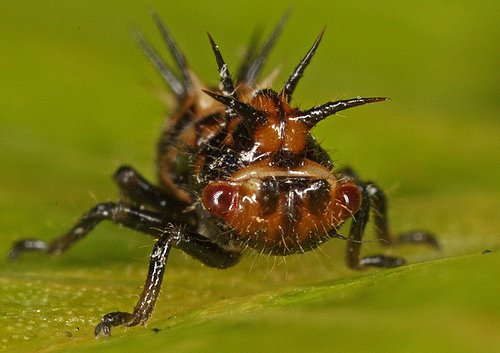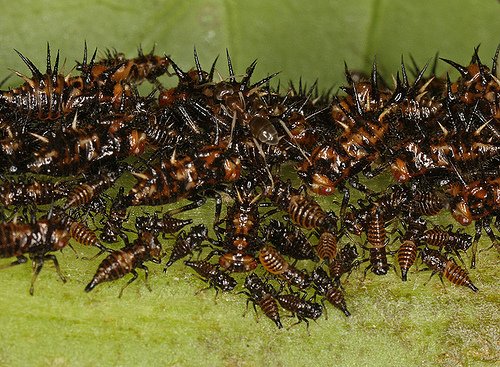
Cute, right?
Every gardener has had the experience of walking out to their garden, only to find a plant (or many) ravaged by a pest they've not encountered before. I had that experience recently, when visiting the somewhat neglected tomato garden up against the house. When picking tomatoes, I found that the tomato plants were covered in these little brown bugs, with spikes on them. There were also similarly shaped green bugs and the same small black biting ants that constantly try to invade the house. Yesterday, John found the name of them Keeled Treehoppers (Antianthe expansa), which I decided to look into further this morning, partially so I could find out what to do about them. What I found is that these are crazy tough little bugs that exist just about everywhere, and they LOVE tomato plants.

A colony of them, they generally are found in large groups.
They're related to aphids, as are the green treehoppers that almost always come with them. They feed by sucking juices and fluids from the tomato plants, through the stems where they sit. The larvae look significantly different and they secrete a honeydew like substance. This sweet sticky substance attracts the black biting ants, who are known to farm tomato plants for this substance. This explains why all three are found in the bad infestation that is on my tomato plants currently.
Keeled treehoppers LOVE anything in the solanacae family, which includes: tomatoes, tomatillos,sweet peppers, chiles, eggplants and potatoes. Their preferred food out of all of them are tomato plants, and there are reports of them all over the US at least, in all climates. They are known for wiping out entire tomato gardens, as they are pretty hard to deal with once you have an infestation.
My searches on the internet taught me they are an extremely common problem. They lay their eggs under tree bark generally, and often infest trees as well, although they prefer tomatoes and their cousins. They are able to hop, as I found out when I was removing dead tomato branches covered in them, yesterday.
They are also wary of people and are known to hide from sight when people approach. This makes it pretty difficult to see them when removing them. I took to blasting them off with water, which apparently is an accepted way of dealing with them, temporarily anyway. One article said they're extremely tough to squish. You can't really use your fingers because they're covered in little thorns. These little thorns are actually how I first noticed them, they are just as sharp as they look. They even went as far as to say that they thought they could only be killed by being smashed with a rock. We think tweezers would do the trick as well, although it'd be tedious in an infestation situation.
The best solution I was able to find in terms of killing them easily, quickly and organically is none other than Neem Tree Oil. It's used for everything from natural spermicide to organic pesticide and fungicide. We've used it for years for spider mites on our cannabis plants, being the only real thing that had an effect followed by Actively Aerated Compost Tea sprayed about a day later. We do have access to organic neem oil here, but it's a bit pricey for me right now, my budget is much smaller than most expats budget. As soon as I have the extra funds though, I intend to use this on my plants to get rid of these thorny pests. Happy Gardening.

A photo of what's left of my infestation, I removed the worst of it. Original Photos
The other photos were found on google, on mrnikon's flickriver account, here (http://www.flickriver.com/photos/55258054@N00/sets/72157622551552769/).
